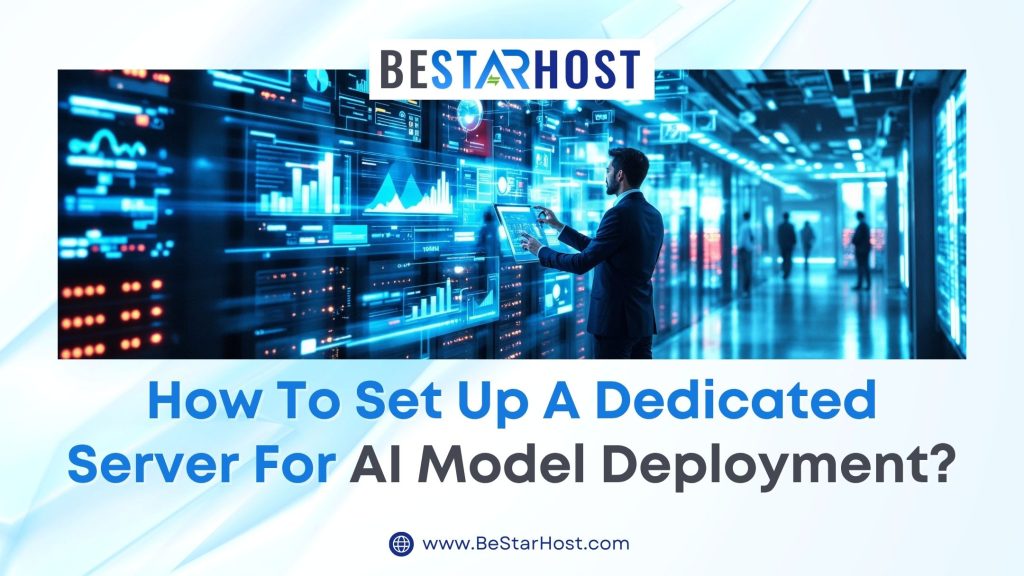
If you’re planning serious AI workloads, a dedicated server for AI model deployment offers consistent performance, full hardware control (especially GPUs / NVMe), and stronger isolation than shared environments. For production-grade AI model hosting on dedicated server, dedicated hardware helps meet latency, throughput, and compliance requirements.
Quick checklist — best server setup for machine learning models
- GPU(s) that match your framework (NVIDIA for CUDA) — ideally multiple GPUs for parallel inference/training
- Powerful CPU (8+ cores) for preprocessing and model orchestration
- High-speed NVMe storage for datasets and model artifacts
- At least 32–128 GB RAM depending on model size
- Low-latency network, public IPs or private VPC as needed
- OS: Ubuntu LTS or CentOS/Fedora with up-to-date kernel
Step-by-step: AI model deployment infrastructure setup
1. Choose hardware & OS
Pick hardware that suits your use-case: for inference, a single high-end GPU may suffice; for training, consider multi-GPU racks. For OS, Ubuntu LTS is common for ML stacks. If you need help, explore our dedicated GPU plans at BeStarHost Dedicated Servers.
2. Install drivers & runtimes
Install GPU drivers (e.g., NVIDIA driver + CUDA, cuDNN) and test with sample workloads. Install Python 3.10+ and create a virtual environment. For framework-specific serving, consider TensorFlow Serving or TorchServe.
# Example (Ubuntu): install Docker and NVIDIA Container Toolkit
sudo apt update
sudo apt install -y docker.io
distribution=$(. /etc/os-release;echo $ID$VERSION_ID)
curl -s -L https://nvidia.github.io/nvidia-docker/gpgkey | sudo apt-key add -
curl -s -L https://nvidia.github.io/nvidia-docker/$distribution/nvidia-docker.list | sudo tee /etc/apt/sources.list.d/nvidia-docker.list
sudo apt update && sudo apt install -y nvidia-docker2
sudo systemctl restart docker
3. Containerize models
Packaging the model and server into a Docker image makes deployment repeatable and portable. Expose a minimal HTTP/GRPC endpoint with the model server. Example serving options:
- TensorFlow Serving — for TensorFlow models
- TorchServe — for PyTorch models
- Custom Flask/FastAPI app + Uvicorn/Gunicorn for light-weight models
4. Reverse proxy and TLS
Use Nginx or Envoy as a reverse proxy for routing, TLS termination, and basic load balancing. Use Let’s Encrypt to provision free TLS certificates and enable HTTPS.
5. Orchestration & process management
For single-server deployments, use systemd or Docker Compose to keep containers running. For scaling to multiple servers, consider Kubernetes or a managed orchestration platform.
6. Monitoring & logging
Implement metrics (Prometheus + Grafana), request tracing, and centralized logs (ELK/Opensearch or Loki). Track GPU utilization, memory pressure, and tail latencies for predictions.
7. CI/CD for models
Automate model build, test, and deployment pipelines. Store artifacts in a model registry, run validation tests, and promote only validated models to production.
Security & cost considerations
Lock down SSH (use keys, disable password auth), keep OS packages updated, and restrict admin access. For AI model hosting on dedicated server in regulated industries, encrypt data at rest and in transit. Balance performance needs with cost — GPU time is expensive, so schedule heavy jobs during off-peak times or use spot resources for non-critical training.
Example minimal architecture
- Client → Nginx (TLS) → Inference container (Docker + NVIDIA runtime)
- Monitoring: Prometheus scraping exporter on server
- Logging: container logs shipped to centralized log service
Further reading & references
- TensorFlow Serving
- TorchServe
- Docker
- Nginx
- Explore BeStarHost’s GPU and dedicated server options: BeStarHost Dedicated Servers
